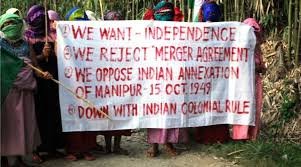How India forced Manipur to merge with its territory
By MNS
Manipur’s merger with India in 1949, signed under controversial circumstances, remains a subject of historical and political dispute. This article examines the forced accession, and the roots of present-day unrest in the state
THE WORLDVIEW
June 28, 2025
THE lush hills of Manipur, nestled in India’s north-eastern frontier region, have long masked a deep historical wound — a wound inflicted not by centuries of colonialism but by a hurried and highly disputed political act in the early years of independent India.
On 21st September, 1949, Maharaja Bodhachandra Singh of Manipur was coerced into signing a "Merger Agreement" that extinguished his kingdom’s sovereignty. Stripped of advisers, legal counsel, or democratic mandate, the king signed under circumstances that many historians now liken to a political hostage situation.
The Indian government, under Prime Minister Jawaharlal Nehru and Home Minister Sardar Vallabhbhai Patel, would declare Manipur a part of the Indian Union just weeks later — a move that remains controversial 78 years on.
Brief sovereign interlude
Manipur was not a feudal relic at the time of the alleged merger. Following Indian independence in 1947, the princely state established a constitutional monarchy under the Manipur State Constitution Act, passed with the king’s consent. In June 1948, Manipur held its first general elections, making it one of the earliest states in South Asia to introduce representative government.
Its elected assembly began functioning with relative autonomy, addressing matters of internal governance. While the state did sign an Instrument of Accession in 1947, conceding only foreign affairs, defence and communications to India, the arrangement mirrored that of other princely states which had opted for limited union without surrendering their autonomy.
According to archival material and testimonies compiled by scholars such as Naorem Sanajaoba and Dr K.K. Ghosh, New Delhi grew increasingly uncomfortable with Manipur’s independent trajectory. As India moved to consolidate its territories, the small, landlocked state was viewed as geopolitically sensitive — bordering Burma (now Myanmar) and susceptible, in Delhi’s view, to "external influence".
The Shillong ultimatum
In September 1949, Maharaja Bodhachandra was summoned to Shillong under the pretext of consultation. Upon arrival, he found himself under constant surveillance. Indian officials, including the powerful V.P. Menon (Sardar Patel’s right-hand man), presented the king with a draft merger agreement and pressured him to sign.
There were no Manipuri legal advisers, no members of the elected Assembly, and no representatives from civil society. The king, reportedly threatened with dire consequences — including a possible military intervention — capitulated. As per multiple accounts, including documents unearthed by the Indian Express, the king signed the agreement on 21st September. The government of India declared the merger effective from 15th October, 1949, pre-dating the king’s return to Imphal and the state assembly’s knowledge of the decision.
When the Assembly eventually convened, it unanimously rejected the merger, arguing that the process violated the constitution of Manipur and the principles of self-determination. Their protests were ignored. On 15th October, Indian troops entered the state, the Assembly was dissolved by executive order, and Manipur was reduced to a “Part-C” state, administered by a Chief Commissioner — a colonial-style administrative category abolished in 1956.
Legal ambiguities and constitutional silence
Notably, no formal ratification of the merger by the Indian Parliament or by the people of Manipur was ever sought. Unlike some other contentious cases, such as Kashmir, no Article in the Indian Constitution preserved a special status for Manipur. The merger was absorbed quietly, administratively, and with little national debate.
In recent years, legal scholars have revisited the episode, arguing that the Shillong agreement does not meet the standards of international law or constitutional practice. Prof A.G. Noorani, a noted legal historian, wrote in Frontline that the Manipur case “raises serious doubts about the legality of India’s claims to democratic procedure during the state integration process”.
Legacy of silenced dissent
The ramifications of the 1949 merger continue to reverberate. Various groups in Manipur — from the United Naga Council to Meitei student unions — invoke this “forced annexation” in arguments against central overreach. Some insurgent groups formed in the 1960s cite 1949 as the genesis of armed resistance.
The Armed Forces (Special Powers) Act, imposed in the state in 1980, and persistent ethnic tensions between the hill and valley communities have added layers to the discontent. Activists like Irom Sharmila and writers like Khumanthem Prakash Singh have drawn attention to this unresolved legacy of injustice.
The present unrest — marked by tribal clashes, a breakdown of civil order, and increasing calls for autonomy — cannot be separated from the unresolved trauma of 1949. While New Delhi continues to celebrate the “integration” of princely states as a success of postcolonial state-building, Manipur’s story remains an exception — a case of integration without consent.
A wound in the hills
As India prepares to mark the 80th anniversary of independence in a few years, there is renewed scholarly and political interest in reassessing how states like Manipur were brought into the fold. The case raises difficult but necessary questions: Can democracy be built on a foundation where consent was never granted? Can peace come to a region whose cries of betrayal have gone unheard for generations?
Until such questions are honestly addressed, the hills of Manipur will continue to bleed — not just from conflict, but from a long and painful memory.
Sources consulted: Indian Express archives (1949–2024); Frontline magazine, legal commentary by A.G. Noorani; “Manipur: Past and Present” by Naorem Sanajaoba; Constituent Assembly Debates and the Manipur State Constitution Act, 1947; Memoirs of V.P. Menon; and Research papers from the Centre for North East Studies (Jamia Millia Islamia)

